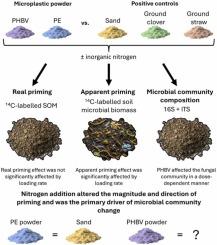无机氮的添加显著增加了土壤中聚乙烯和PHBV微塑料的实际和表观启动效应
IF 11.3
1区 环境科学与生态学
Q1 ENGINEERING, ENVIRONMENTAL
引用次数: 0
摘要
塑料地膜(PMFs)提高了作物产量,但会降解为微塑料,这引起了人们对其对土壤健康影响的担忧。本研究比较了常规聚乙烯(PE)和可生物降解聚(3-羟基丁酸-co-3-羟基戊酸酯)(PHBV)微塑料通过实际(天然)和表观(微生物生物量)启动效应对土壤有机质(SOM)周转的影响。使用14c标记法,我们评估了添加氮(80 kg N ha-1)和不添加氮的三种微塑料加载率(10、100、1000 kg ha-1)。比较对惰性砂和有机残留物(三叶草,稻草)的反应。添加氮显著提高了各处理的实激发效应。PHBV引起剂量依赖性(尽管不显著)的正启动,大于等效的稻草或三叶草负载。一般来说,无氮时的表观启动为负,有氮时为正,表明微生物的反应取决于底物化学计量和可及性。微生物(16S rRNA和ITS2)测序结果显示,N的添加主要驱动细菌群落的变化,而PHBV则独特地改变了真菌群落,以剂量依赖的方式增加子囊菌群的优势。PE的表现与惰性砂相似,表明对SOM周转的影响最小。虽然可生物降解塑料减少了传统的微塑料积累,但PHBV可能会通过注入增加SOM的损失(本研究中没有发现直接的类似物),对土壤碳储量有潜在的长期影响。这些发现强调了在更广泛的土壤养分和碳循环框架中评估可生物降解塑料的重要性。本文章由计算机程序翻译,如有差异,请以英文原文为准。

Addition of inorganic nitrogen significantly increases the real and apparent priming effects of polyethylene and PHBV microplastics in soil
Plastic mulch films (PMFs) enhance crop productivity but degrade into microplastics, raising concerns about their effects on soil health. This study compared the effect of conventional polyethylene (PE) and biodegradable poly(3-hydroxybutyrate-co-3-hydroxyvalerate) (PHBV) microplastics on soil organic matter (SOM) turnover through real (native SOM) and apparent (microbial biomass) priming effects. Using 14C-labelled assays, we assessed three microplastic loading rates (10, 100, 1000 kg ha-1) with addition of nitrogen (N) (80 kg N ha-1), and without. Comparing responses to inert sand and organic residues (clover, straw). Nitrogen addition significantly enhanced real priming in all treatments. PHBV caused dose-dependent (although non-significant) positive priming, greater than equivalent straw or clover loading. Generally, apparent priming was negative without N but positive with N, suggesting microbial responses depend on substrate stoichiometry and accessibility. Microbial (16S rRNA and ITS2) sequencing showed that N addition mainly drove bacterial community changes, while PHBV uniquely altered fungal communities, increasing Ascomycota dominance in a dose-dependent manner. PE behaved similarly to inert sand, indicating minimal impact on SOM turnover. While biodegradable plastics reduce conventional microplastic accumulation, PHBV may enhance SOM loss via priming (with no direct analogue found in this study), with potential long-term consequences for soil carbon stocks. These findings emphasise the importance of evaluating biodegradable plastics within broader soil nutrient and carbon cycling frameworks.
求助全文
通过发布文献求助,成功后即可免费获取论文全文。
去求助
来源期刊

Journal of Hazardous Materials
工程技术-工程:环境
CiteScore
25.40
自引率
5.90%
发文量
3059
审稿时长
58 days
期刊介绍:
The Journal of Hazardous Materials serves as a global platform for promoting cutting-edge research in the field of Environmental Science and Engineering. Our publication features a wide range of articles, including full-length research papers, review articles, and perspectives, with the aim of enhancing our understanding of the dangers and risks associated with various materials concerning public health and the environment. It is important to note that the term "environmental contaminants" refers specifically to substances that pose hazardous effects through contamination, while excluding those that do not have such impacts on the environment or human health. Moreover, we emphasize the distinction between wastes and hazardous materials in order to provide further clarity on the scope of the journal. We have a keen interest in exploring specific compounds and microbial agents that have adverse effects on the environment.
 求助内容:
求助内容: 应助结果提醒方式:
应助结果提醒方式:


